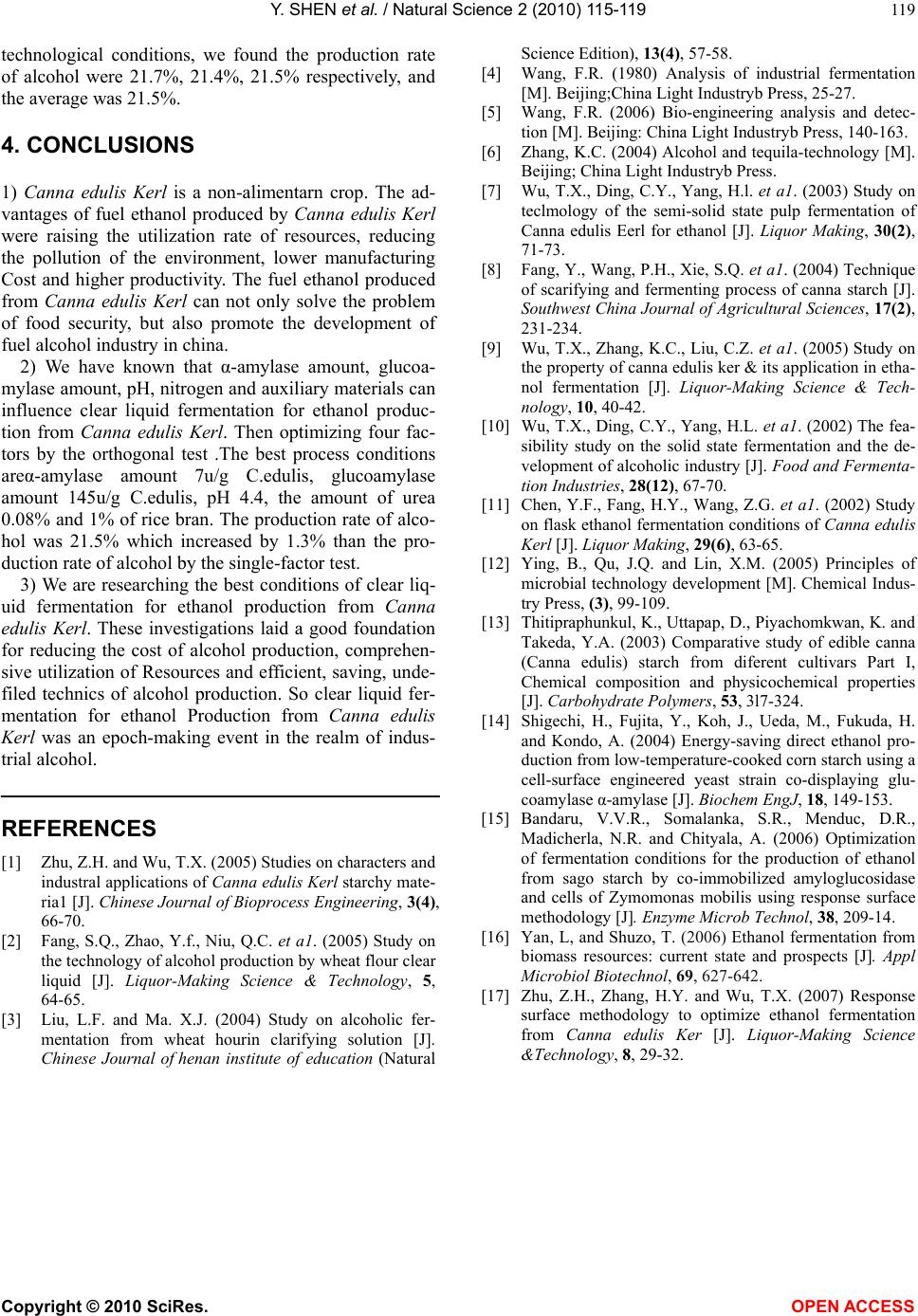
Y. SHEN et al. / Natural Science 2 (2010) 115-119
Copyright © 2010 SciRes. OPEN ACCESS
119
technological conditions, we found the production rate
of alcohol were 21.7%, 21.4%, 21.5% respectively, and
the average was 21.5%.
4. CONCLUSIONS
1) Canna edulis Kerl is a non-alimentarn crop. The ad-
vantages of fuel ethanol produced by Canna edulis Kerl
were raising the utilization rate of resources, reducing
the pollution of the environment, lower manufacturing
Cost and higher productivity. The fuel ethanol produced
from Canna edulis Kerl can not only solve the problem
of food security, but also promote the development of
fuel alcohol industry in china.
2) We have known that α-amylase amount, glucoa-
mylase amount, pH, nitrogen and auxiliary materials can
influence clear liquid fermentation for ethanol produc-
tion from Canna edulis Kerl. Then optimizing four fac-
tors by the orthogonal test .The best process conditions
areα-amylase amount 7u/g C.edulis, glucoamylase
amount 145u/g C.edulis, pH 4.4, the amount of urea
0.08% and 1% of rice bran. The production rate of alco-
hol was 21.5% which increased by 1.3% than the pro-
duction rate of alcohol by the single-factor test.
3) We are researching the best conditions of clear liq-
uid fermentation for ethanol production from Canna
edulis Kerl. These investigations laid a good foundation
for reducing the cost of alcohol production, comprehen-
sive utilization of Resources and efficient, saving, unde-
filed technics of alcohol production. So clear liquid fer-
mentation for ethanol Production from Canna edulis
Kerl was an epoch-making event in the realm of indus-
trial alcohol.
REFERENCES
[1] Zhu, Z.H. and Wu, T.X. (2005) Studies on characters and
industral applications of Canna edulis Kerl starchy mate-
ria1 [J]. Chinese Journal of Bioprocess Engineering, 3(4),
66-70.
[2] Fang, S.Q., Zhao, Y.f., Niu, Q.C. et a1. (2005) Study on
the technology of alcohol production by wheat flour clear
liquid [J]. Liquor-Making Science & Technology, 5,
64-65.
[3] Liu, L.F. and Ma. X.J. (2004) Study on alcoholic fer-
mentation from wheat hourin clarifying solution [J].
Chinese Journal of henan institute of education (Natural
Science Edition), 13(4), 57-58.
[4] Wang, F.R. (1980) Analysis of industrial fermentation
[M]. Beijing;China Light Industryb Press, 25-27.
[5] Wang, F.R. (2006) Bio-engineering analysis and detec-
tion [M]. Beijing: China Light Industryb Press, 140-163.
[6] Zhang, K.C. (2004) Alcohol and tequila-technology [M].
Beijing; China Light Industryb Press.
[7] Wu, T.X., Ding, C.Y., Yang, H.l. et a1. (2003) Study on
teclmology of the semi-solid state pulp fermentation of
Canna edulis Eerl for ethanol [J]. Liquor Making, 30(2),
71-73.
[8] Fang, Y., Wang, P.H., Xie, S.Q. et a1. (2004) Technique
of scarifying and fermenting process of canna starch [J].
Southwest China Journal of Agricultural Sciences, 17(2),
231-234.
[9] Wu, T.X., Zhang, K.C., Liu, C.Z. et a1. (2005) Study on
the property of canna edulis ker & its application in etha-
nol fermentation [J]. Liquor-Making Science & Tech-
nology, 10, 40-42.
[10] Wu, T.X., Ding, C.Y., Yang, H.L. et a1. (2002) The fea-
sibility study on the solid state fermentation and the de-
velopment of alcoholic industry [J]. Food and Fermenta-
tion Industries, 28(12), 67-70.
[11] Chen, Y.F., Fang, H.Y., Wang, Z.G. et a1. (2002) Study
on flask ethanol fermentation conditions of Canna edulis
Kerl [J]. Liquor Making, 29(6), 63-65.
[12] Ying, B., Qu, J.Q. and Lin, X.M. (2005) Principles of
microbial technology development [M]. Chemical Indus-
try Press, (3), 99-109.
[13] Thitipraphunkul, K., Uttapap, D., Piyachomkwan, K. and
Takeda, Y.A. (2003) Comparative study of edible canna
(Canna edulis) starch from diferent cultivars Part I,
Chemical composition and physicochemical properties
[J]. Carbohydrate Polymers, 53, 3l7-324.
[14] Shigechi, H., Fujita, Y., Koh, J., Ueda, M., Fukuda, H.
and Kondo, A. (2004) Energy-saving direct ethanol pro-
duction from low-temperature-cooked corn starch using a
cell-surface engineered yeast strain co-displaying glu-
coamylase α-amylase [J]. Biochem EngJ, 18, 149-153.
[15] Bandaru, V.V.R., Somalanka, S.R., Menduc, D.R.,
Madicherla, N.R. and Chityala, A. (2006) Optimization
of fermentation conditions for the production of ethanol
from sago starch by co-immobilized amyloglucosidase
and cells of Zymomonas mobilis using response surface
methodology [J]. Enzyme Microb Technol, 38, 209-14.
[16] Yan, L, and Shuzo, T. (2006) Ethanol fermentation from
biomass resources: current state and prospects [J]. Appl
Microbiol Biotechnol, 69, 627-642.
[17] Zhu, Z.H., Zhang, H.Y. and Wu, T.X. (2007) Response
surface methodology to optimize ethanol fermentation
from Canna edulis Ker [J]. Liquor-Making Science
&Technology, 8, 29-32.